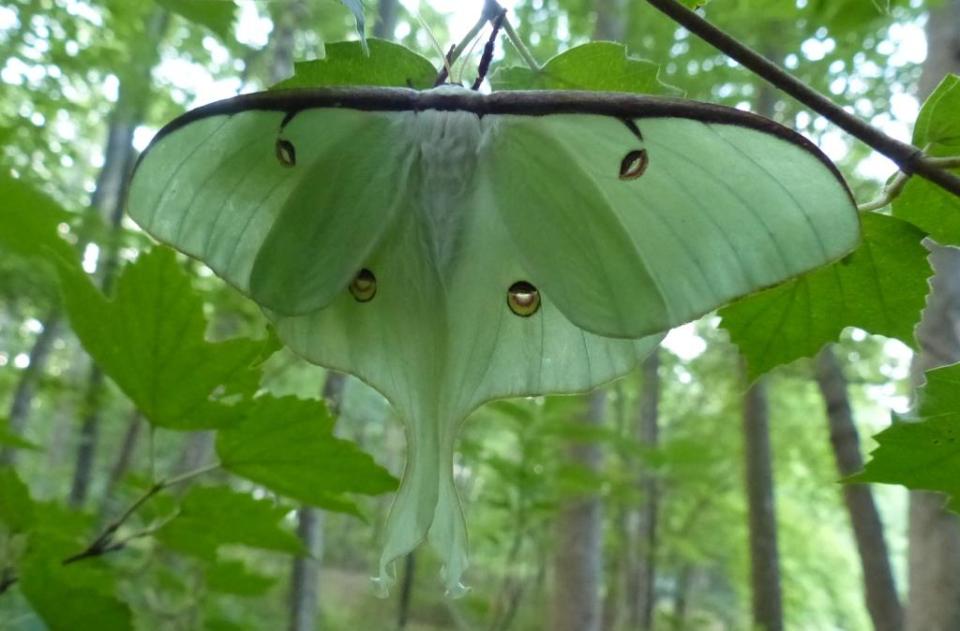 Morning light flows through another arthropod: the luna moth, showing the spring-leaf green of her wings. The brown leading edge is a great match for the viburnum twig on which she rests.
Morning light flows through another arthropod: the luna moth, showing the spring-leaf green of her wings. The brown leading edge is a great match for the viburnum twig on which she rests.
This species belongs to a larger grouping, the Asian-American moon moths. Like the trees on which they feed, these American and Asian insects look very similar (here are a couple of examples of look-alikes, and then some more crazy-winged cousins). They have a distribution that encompasses the east of North America and parts of Asia, reflecting the old biogeographic continuity of these places.
Unfortunately, parasitic flies introduced to North America to control gypsy moths are turning their attentions to the luna moth. So far, lunas appear to be more robust than most other large moth species, many of which are in decline or have gone regionally extinct, at least in New England. We lack long-term data (to my knowledge) on populations of moths in the south.
Why such long tails? Bat befuddlement. Ed Yong tells this luna-tale, with a review of some cool experiments, along with videos, on his fabulous blog at National Geographic.
Closing moth thoughts as they antennate the air’s breath, seeking pheromonal scent (attributed to Rumi from, as far as I can tell, Coleman Barks’ interpretations of English translations):
“At night, I open the window and ask the moon to come and press its face against mine. Breathe into me. Close the language-door and open the love-window. The moon won’t use the door, only the window.”
I live in southern Vermont. Moved into this Green Mountain rural home 8 years ago, and have had luna moths at my bedroom window every year since I’ve been here except this year. This year there have been very few moths at all, and no giant silkworms. Last year I had four on my window at one time, the most ever. Very sad not to see them this year, and I hope you’re wrong about their being regionally extinct in New England. When I saw the first one here 8 years ago, that was the first one I’d seen since I left Louisiana 25 years ago.
I hope so too. My understanding is that only in only some parts of NE are they in decline. Their other silk-moth cousins are faring more poorly. I hope that yours return!
Thank you, David. Me too! I’ve had the luna and polyphemous for the last several years. None of that this year. We had an incredibly cold winter and then a spring drought. Perhaps that explains this year. But with all the stresses of climate change, and a skipped generation, I worry.
Yes, the “margin of error” is narrowing for too many species.
Moon moth and a Blue Moon.
Aye. Quite a month of July.
So beautiful! Had it been a male, the antennae would have been heftier?
Thank you. Yes, they have somewhat bigger, fluffier antennae.
Thank you for these astute and exquisite micro-glimpses into our planet’s ecology.
Thank you, Kat.
This is very nice! I love how the light shines through their green wings. We just do not see them in nature in northern Illinois, but our local butterfly house had so many this year, I did a post on them a couple moths ago: https://beehappeenow.wordpress.com/2015/05/30/luna-moths-lunar-craters-and-best-teachers/
And kids really liked them. Sad to hear that parasitic flies may be hurting their population.
By the way, I absolutely love your book “Forest Unseen”, here, it sits on the same shelf as Thoreau. :)
Thank you. I’m very honored to be on that shelf, albeit with less heft in the pages than Mr. T. You had a great lunar convergence in your blog!
“Forest Unseen” absolutely the best contemporary nature writing book I had read, it really rekindled my forgotten love for biology, which I had in high school, and your book, like a great biology teacher brought that curiosity back. I had discussed many parts with my young kids. So thank you very much.
We are seeing a very decreased monarch population around here too. Although the bees, including bumble bees seem to have had somewhat of a comeback.
I am very happy to hear of your rekindled love for bio, and that you are sharing morsels from the book with your kids. Thank you!
Loved learning how the Luna’s tail foils bat attacks! You always bring such a unique, interesting perspective to the critters around us.
Thank you! And thank you to Ed Yong who does such a great job at his blog: he’s a great writer with an ear for the heart of a story.
the above post reminded me that I never read your book. I’ll start tonight.
Pingback: Light, sound, hummingbird wings | Ramble